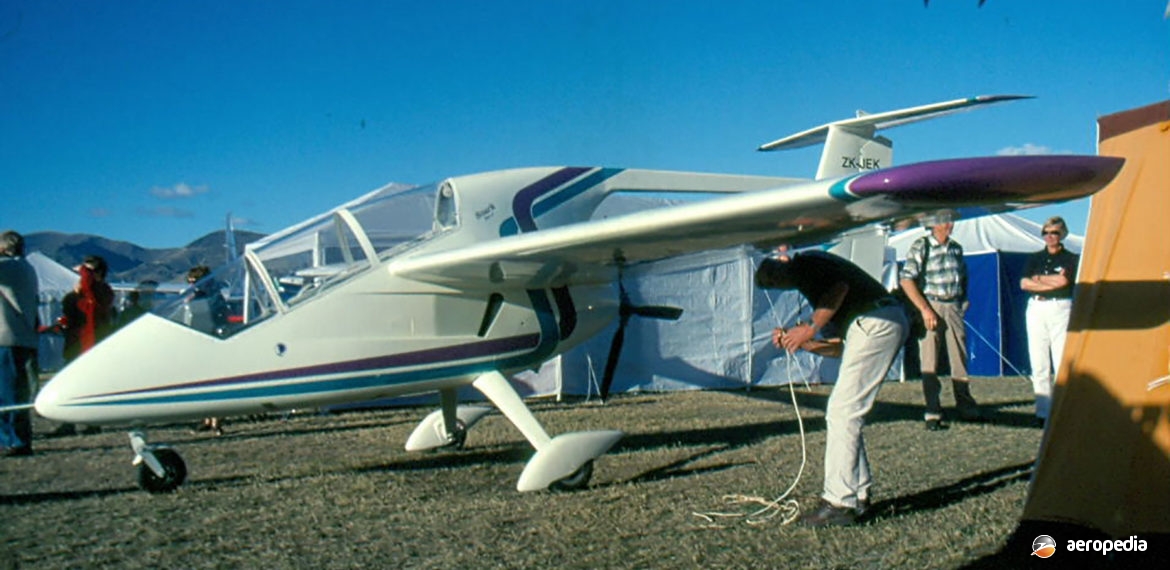Photograph:
Barber Snark HA-3 ZK-JEK (c/n MAANZ/528) at Wanaka, NZ in 1996 (David C Eyre)
Country of origin:
New Zealand
Description:
Single or two-seat light sport monoplane
Power Plant:
One 60 kw (80 hp) SOHC Suzuki Swift G-13 GTI four-cylinder air-cooled engine
Specifications:
- Wingspan: 9.3 m (30 ft 6 in)
- Length: 6.24 m (20 ft 5 in)
- Height: 2.43 m (8 ft)
- Wing area: 11.79 m² (132.93 sq ft)
- Max speed: 225 km/h (140 mph)
- Cruising speed: 205 km/h (128 mph)
- Stalling speed power off no flaps: 66 km/h (41 mph)
- Stalling speed power off with flaps: 61 km/h (38 mph)
- Rate of climb: 427 m/min (1,400 ft/min)
- Service ceiling: 3,658 m (12,000 ft)
- Range: 1,040 km (650 miles)
- Fuel capacity: 60 litres (13.2 Imp gals)
- Landing roll: 110 m (361 ft)
- Empty weight: 331 kg (730 lb)
- Useful load: 190 kg (419 lb)
- Loaded weight: 520 kg (1,145 lb)
History:
The Barber Snark was a microlight aircraft designed by William Barber of Queenstown on the south island of New Zealand, being his third aircraft design. A single or two-seater, it made extensive use of composite materials, mainly carbon fibre and Kevlar. Seating was in tandem, the second seat being elevated for better vision.
The first aircraft in the series was ZK-FOU, which was built on the designer’s property at Dacre and, flown for the first time in 1987, had the propeller mounted behind the tail driven through a shaft from the mid-mounted engine. This aircraft is dealt with separately.
Development of the design continued over the years, changes being made in construction and design of the wing, a number of different power plants being installed. Pilots described the aircraft as ‘handling like a Cessna 152 with well co-ordinated controls’. Fitted with a tricycle undercarriage, it had a 60 kw (80 hp) Suzuki G13 engine of 1,323 cc, which was of alloy construction and was capable of 6,000 rpm, but was restricted to 5,000 rpm. Consideration was also given to the installation of Rotax or Jabiru engines.
The first aircraft built was known as the HA-1 ZK-FOU (c/n MAANZ/063 – later 409) and was a single-seat all-composite construction aircraft with a mid-mounted engine driving the propeller through a shaft, the propeller being mounted behind the tail. This model, powered by a Rotax 503 engine, was first registered on 11 August 1987 and, other than for a few short hops, was never flown and, after a little testing, was withdrawn from use in July 1995.
The second Snark built was known as the HA-2 ZK-FYE (c/n MAANZ/460) and this was designed as a two-seat microlight aircraft under New Zealand regulations, being registered on 30 May 1991. It was of welded steel tube frame construction with the wing structure and the tail boom built of composites, the wings and tail surfaces being fabric covered. It also was powered by a Rotax 503 engine. It was damaged in a take-off accident on 26 March 2001 and needed some reconstruction work. It was sold in 2001 and became ZK-DQL² with its new owner at Invercargill.
The next aircraft built was known as the Snark HA-3 ZK-JEK (c/n 001 – MAANZ/528) and was registered on 20 March 1995. It was of all-composite construction but had a newly designed wing of less area and of laminar section, having full span flaperons. This aircraft was fitted with a Suzuki G13 engine. It was used to carry out the 40 hour test programme.
This was followed by ZK-PIE (c/n 002) registered in early 1996 to Mr David Laing of Dunedin. It was similar to c/n 001 except it had separate flaps and ailerons and, fitted with a Suzuki G13 engine, it has been referred to as the HA-3B.
The next aircraft built was ZK-JIU (c/n 003), which became known as an HA-3B, and was similar to ZK-PIE, having a Suzuki G13 GTI engine. This aircraft was exported to Australia where it was registered under AUF / RAA Regulations as 19-3116 in March 2016, being based at Mildura, VIC.
As noted, development continued and it was expected the Snark would become available in two variants, the HA-2B with a Rotax 503 engine providing a cruising speed of 129 km/h (80 mph) aimed at the microlight market; and the HA-3B with a four-stroke fuel-injected engine providing a cruising speed of 193 km/h (120 mph), aimed at the general aviation or experimental market.

